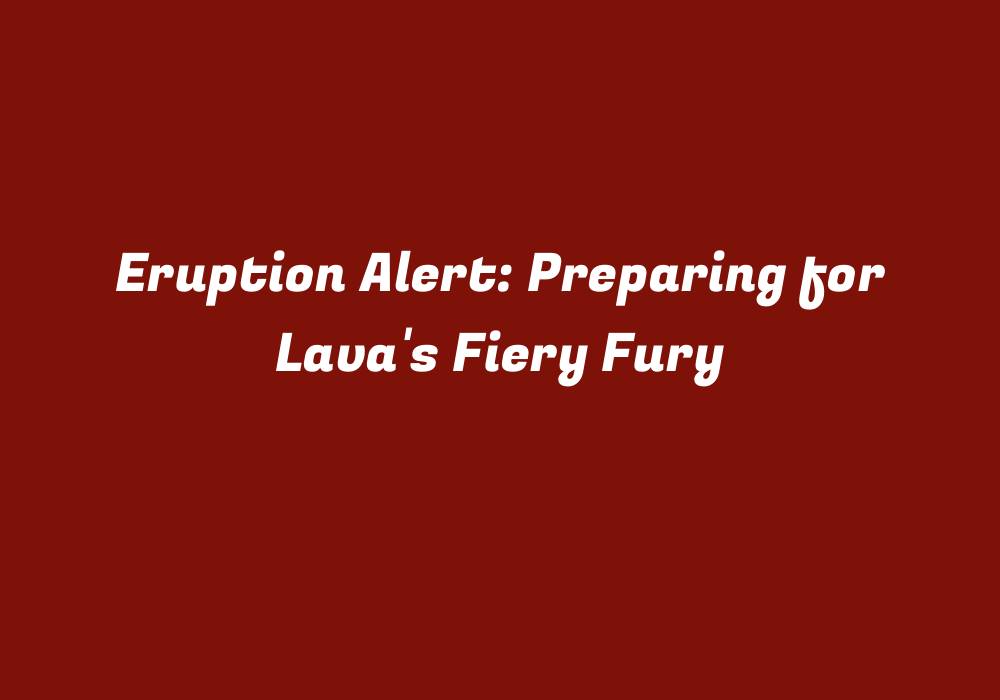Understanding Lava Eruptions: A Brief Introduction
Lava eruptions, also known as volcanic eruptions or magmatic activity, are explosive phenomena that release heat and molten rock into the Earth’s atmosphere. While these events occur sporadically, they significantly affect the landscape and environment where they take place. Over time, volcanic activity can lead to the formation of new landmasses and change the geological structure beneath the Earth’s surface.
In this article, we will explore some essential aspects of lava eruptions and provide guidelines on how to prepare for their potentially destructive impact when one occurs in a populated area. Our goal is to raise awareness and promote better understanding of these natural phenomena to help mitigate the risks and consequences associated with volcanic activity.
Types of Lava Eruptions
Lava eruptions can be categorized into several types, depending on their nature. These are the most common types:
1. Effusive eruptions occur when magma slowly reaches the Earth’s surface, resulting in the formation of lava flows, such as lava fountains and pahoehoe (rope-like) lava. This type of eruption is relatively gentle compared to explosive events, although it can still cause damage to surrounding structures if it comes into contact with inhabited areas.
2. Explosive eruptions involve the rapid release of volcanic gases and steam that combines with water from the ground. This mixture becomes superheated, leading to an increase in pressure inside the volcano’s conduit. When this pressure is unable to be released through the lava flow channels, it causes fragmentation and produces a violent explosion. Ash clouds can also form during explosive eruptions, which can lead to airborne hazards, ash falls, and potential health issues for nearby communities.
Preparing for Lava Eruptions: A Comprehensive Guide
In order to minimize the risks associated with lava eruptions, it is crucial to prepare both geographically and logistically in advance of any potential activity. Here are some essential steps to take before and during an eruption:
1. Monitor volcanic activity closely: Keep informed about local seismic and volcanic activity by following news reports and official government updates from the relevant agencies. Stay aware of warning signs such as increased earthquake frequency or changes in steam plumes emitted by the volcano.
2. Develop an emergency response plan: Collaborate with community leaders, first responders, and local authorities to create a well-coordinated plan for handling potential emergencies during an eruption. This should include evacuation routes, shelters, medical and rescue services, food and water distribution points, and communication channels.
3. Protect the environment: Assess the environmental impact of lava flows on nearby habitats and wildlife, and implement measures to reduce the effects of volcanic activity on ecosystems. This may include establishing buffer zones around the eruption area or conducting restoration efforts after the event has occurred.
4. Secure infrastructure: Work with local government agencies to ensure that essential infrastructure, such as roads, bridges, water supplies, and communication networks, are designed and maintained to withstand the potential hazards of lava flows. This may include rerouting critical infrastructure away from high-risk zones.
5. Train and educate residents: Conduct regular drills and simulations to familiarize community members with emergency procedures in the event of a volcanic eruption. Additionally, disseminate educational materials and information on lava eruptions, including safety tips and evacuation guidelines, to help residents better prepare themselves and their loved ones.
Conclusion
Lava eruptions have the potential to cause significant destruction and pose a threat to human life in areas of high volcanic activity. To minimize these risks, it is essential for communities to be well-prepared with comprehensive emergency response plans, environmental conservation strategies, and robust infrastructure protection measures. By increasing awareness and understanding of lava eruptions, we can better prepare ourselves and our loved ones for the fiery fury of volcanic events that may impact our lives at any given time.
